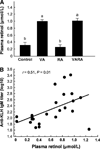Neonatal-age treatment with vitamin A delays postweaning vitamin A deficiency and increases the antibody response to T-cell dependent antigens in young adult rats fed a vitamin A-deficient diet
- PMID: 17449586
- PMCID: PMC3843133
- DOI: 10.1093/jn/137.5.1229
Neonatal-age treatment with vitamin A delays postweaning vitamin A deficiency and increases the antibody response to T-cell dependent antigens in young adult rats fed a vitamin A-deficient diet
Abstract
Vitamin A supplementation for infants and young children is recommended by WHO/UNICEF for countries with a high prevalence of vitamin A deficiency, and vitamin A is often administered at immunization contacts. Using a rat model, we tested whether supplementation with vitamin A or other retinoids at the time of neonatal immunization has prospective benefit in terms of preventing postweaning vitamin A deficiency and promoting antibody responses to T-cell dependent (TD) antigens administered at the neonatal stage and at the young adult stage. Rats were treated orally on postnatal d 6-8 with oil (placebo control), vitamin A, retinoic acid, or a combination of both (VARA) (n > or = 12/group), and immunized with tetanus toxoid (TT) on d 7. The primary anti-TT response was measured on d 21, after which weanling rats were fed the vitamin A-deficient diet until approximately 10 wk. At 8 wk, rats were immunized again with TT to determine the recall response, and with a novel TD antigen, keyhole limpet hemocyanin (KLH), to assess the adult primary response. None of the supplements affected the plasma titer of anti-TT immunoglobulin G (IgG) on d 21 (P = 0.25). However, neonatal-age supplementation with vitamin A or VARA at the young adult stage resulted in: >5 times higher anti-TT IgG recall response (P < 0.01); 5- and 9-times higher anti-KLH primary IgM and IgG responses, respectively (P < 0.05), and plasma retinol in the normal range (approximately 1.0 micromol/L vs. approximately 0.35 micromol/L in retinoic acid-treated and control groups, P < 0.0001). We conclude that early-life supplementation with vitamin A or VARA can prospectively benefit the primary and recall antibody responses to TD antigens administered at the young adult stage, which may involve the maintenance of normal plasma retinol levels.
Conflict of interest statement
Author disclosures: S. Sankaranarayanan, no conflicts of interest; Y. Ma, no conflicts of interest; M. C. Bryson, no conflicts of interest; N-Q Li, no conflicts of interest; and A. C. Ross, no conflicts of interest.
Figures




Similar articles
-
Lung retinyl ester is low in young adult rats fed a vitamin A deficient diet after weaning, despite neonatal vitamin A supplementation and maintenance of normal plasma retinol.J Nutr. 2007 Oct;137(10):2213-8. doi: 10.1093/jn/137.10.2213. J Nutr. 2007. PMID: 17885000 Free PMC article.
-
All-trans-retinoic acid and polyriboinosinoic:polyribocytidylic acid cooperate to elevate anti-tetanus immunoglobulin G and immunoglobulin M responses in vitamin A-deficient lewis rats and Balb/c mice.Proc Nutr Soc. 2000 Nov;59(4):519-29. doi: 10.1017/s0029665100000756. Proc Nutr Soc. 2000. PMID: 11115786
-
Immunological memory to tetanus toxoid is established and maintained in the vitamin A-depleted rat.FASEB J. 1991 Jul;5(10):2473-81. doi: 10.1096/fasebj.5.10.2065894. FASEB J. 1991. PMID: 2065894
-
Oral vitamin A and retinoic acid supplementation stimulates antibody production and splenic Stra6 expression in tetanus toxoid-immunized mice.J Nutr. 2012 Aug;142(8):1590-5. doi: 10.3945/jn.112.161091. Epub 2012 Jun 27. J Nutr. 2012. PMID: 22739370 Free PMC article.
-
Vitamin A supplementation and retinoic acid treatment in the regulation of antibody responses in vivo.Vitam Horm. 2007;75:197-222. doi: 10.1016/S0083-6729(06)75008-7. Vitam Horm. 2007. PMID: 17368317 Free PMC article. Review.
Cited by
-
Liver-specific cytochrome P450 CYP2C22 is a direct target of retinoic acid and a retinoic acid-metabolizing enzyme in rat liver.J Lipid Res. 2010 Jul;51(7):1781-92. doi: 10.1194/jlr.M002840. Epub 2010 Feb 10. J Lipid Res. 2010. PMID: 20147703 Free PMC article.
-
Lung retinyl ester is low in young adult rats fed a vitamin A deficient diet after weaning, despite neonatal vitamin A supplementation and maintenance of normal plasma retinol.J Nutr. 2007 Oct;137(10):2213-8. doi: 10.1093/jn/137.10.2213. J Nutr. 2007. PMID: 17885000 Free PMC article.
-
Vitamin A and retinoic acid in T cell-related immunity.Am J Clin Nutr. 2012 Nov;96(5):1166S-72S. doi: 10.3945/ajcn.112.034637. Epub 2012 Oct 10. Am J Clin Nutr. 2012. PMID: 23053562 Free PMC article. Review.
-
Impact on allergic immune response after treatment with vitamin A.Nutr Metab (Lond). 2009 Oct 23;6:44. doi: 10.1186/1743-7075-6-44. Nutr Metab (Lond). 2009. PMID: 19852821 Free PMC article.
-
Dual immune modulatory effect of vitamin A in human visceral leishmaniasis.PLoS One. 2014 Sep 30;9(9):e107564. doi: 10.1371/journal.pone.0107564. eCollection 2014. PLoS One. 2014. PMID: 25268355 Free PMC article.
References
-
- Stephensen CB. Vitamin A, infection, and immune function. Annu Rev Nutr. 2001;21:167–192. - PubMed
-
- Schultink W. Use of under-five mortality rate as an indicator for vitamin A deficiency in a population. J Nutr. 2002;132:2881S–2883S. - PubMed
-
- Fawzi WW, Chalmers TC, Herrera MG, Mosteller F. Vitamin A supplementation and child mortality. A meta-analysis. JAMA J Am Med Assoc. 1993;269:898–903. - PubMed
-
- Sommer A, West KP., Jr . Vitamin A deficiency: health, survival, and vision. New York: Oxford University Press; 1996.
Publication types
MeSH terms
Substances
Grants and funding
LinkOut - more resources
Full Text Sources
Medical

